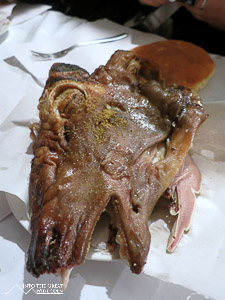Marrakesh, Morocco
Street Cinema
January 7, 2013
You can't always get what you want
But if you try sometime you just might find
You get what you need
- Rolling Stones

The Marrakesh Medina is a city inside of a city. The roads from the train station and bus station lead towards it, as they cross the boundaries demarcated by the old city walls they change from normal roads into a maze of jagged routes. These routes crisscross the Medina, meandering around buildings and squares, creating a confusing mess of unlabeled traffic arteries. At the center of the Medina is the sprawling Djemaa El-Fna, a sort of massive main square.
In the daylight the square is a center piece for all sorts of merchants, snake charmers, animal exhibitors, juice stands, and pretty much anything you could imagine. At night the square transforms into a large outdoor dining hall with row upon row of temporary food stalls serving all sorts of fresh, delicious, and cheap food of all varieties.

There are sheep heads, soups, sandwiches, grilled meats, seafood, and other assorted delicacies. The workers at the numbered food stalls compete with each other to lure tourists in for a meal. It becomes difficult to decide as many stalls have the same displays and the same menus with the same prices. In the end it is hard to make a wrong decision.
The same goes for the labyrinth of passageways that make up the souks. This confusing tangle of covered alleyways unfolds like a random variety store. The lack of any posted prices and impossibility of knowing a good price make it difficult not to lose at least a small amount of dirhams here. There are certainly some good bargains but you definitely need to be savvy and know what you are buying. On top of all this activity is the activity of everyday life.

Through these crowded and narrow alleyways and streets motorbikes and bicycles fly by, miraculously not colliding with or injuring inattentive pedestrians. Each side of the paths is usually lined with local people just relaxing amidst the chaos and watching the street life unfold before them. It is like a live street cinema, but better in the sense that it offers the possibility of interaction.
As a former imperial city Marrakech has some amazing buildings to show off. The Ali Ben Youssef Madrasa features intricate carvings and extreme levels of detail. The Dar Si Said museum and Bahia Palace display fabulously decorated ceilings and courtyards. The contrastingly empty and barren Badi Palace is impressive for its scale and its resident population of nesting storks.

The palace also highlights the temporary nature of this type of grandeur, having been destroyed only 75 years after being finished. This wasn’t the case with the glittering Saadian Tombs, hidden down a very narrow walkway, and only re-discovered in 1917; these tombs illustrate just how simple it can be to hide treasures inside the disorienting tangle of the Medina’s streets.
Outside the walls of the Medina a new city is encroaching, one lined with modern buildings, well kept restaurants, and fast food. Luckily for Marrakech and the rest of the world, the old city seems impervious to this and the two remain very separate. What the new city lacks in character it more than makes up for in modern conveniences, and it isn’t quite as busy as the old city.

With so much life happening all around you all the time in the old city it wears your senses down. Maybe that’s why there are several nice gardens scattered about the new city. The pastel colors and tranquil setting in the Jardin Majorelle are a welcome relief from the careening motorbikes and aggressive salesmen.
As direct as daily life can be in Marrakech, the winter is a great time to visit because you can enjoy the city in small doses at a reasonable pace. The bouts of hectic street life can be tempered with basking the hot sun on a rooftop terrace and enjoying so much, possibly too much, good food. With that being said, I don’t know if I would come back in the summer when it is 115 degrees; in that case I might opt for the air conditioned convenience the new city would provide.





























































